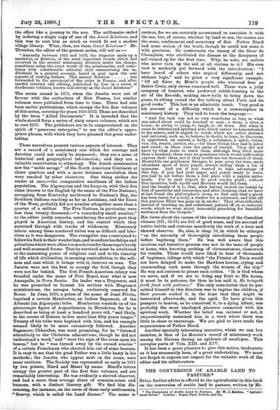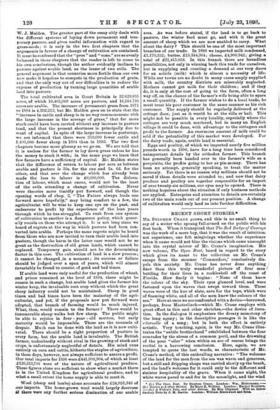• The Conversion of Arable Land to Pasture. By W.
J Malden, " Agricul. tnral Series." London : Kegan Paul, Trench. and Co. W. J. Malden. The greater part of the essay ably deals with the different systems of laying down permanent and tem-
porary pasture, and gives useful information with regard to grass-seeds ; it is only in the two first chapters that the arguments in favour of a change of cultivation are contained.
It must be confessed that the " pros " and "cons." are so evenly balanced in these chapters that the reader is left to come to his own conclusions, though the author evidently inclines to pasture against arable land, as the lesser of two evils. The general argument is that countries more fertile than our own now make it hopeless to compete in the production of grain, and that the only way out of our difficulties is to reduce the expense of production by turning large quantities of arable land into pasture.
The total cultivated area in Great Britain is 32 629,855 acres, of which 16,405,069 acres are pasture, and 16,164 736 acres are arable. The increase of permanent grass from 1871 to 1894 is 4,392,213, but Mr. Malden goes on to state that the "increase in cattle and sheep is in no way commensurate with the large increase in the acreage of grass," that far more stock could have been carried without any increase in pasture land, and that the present shortness is principally due to want of capital. In spite of the large increase in pasturage, we are informed that there were 350,000 fewer cattle and 1,400,000 fewer sheep in 1894 than in 1893. The two first chapters become more gloomy as we go on. We are told that it is useless for the farmer to lay down grass unless he has the money to stock it with ; in the same page we learn that few farmers have a sufficiency of capital. Mr. Malden states that the difference of return to labour per acre as between arable and pasture is 30s. for the one and 2s. 6d. for the other, and that over the change which has already been made the loss to labour is £6,000,000. The disloca- tion of labour, which must ensue, would not be the least 'of the evils attending a change of cultivation. Never were theories more timidly put forward, and though the ,opening words of chap. 2, "The Future always leads one -forward more hopefully," may bring comfort to a few, the agriculturist will be wise to keep one eye on the past, and endeavour to profit by the experience of the lean years through which he has struggled. To rush from one system of cultivation to another is a dangerous policy, which gener- ally recoils on those who attempt it. It is not long since we heard of regrets at the way in which pasture had been con- verted into arable. Perhaps the same regrets might be heard from those who are now invited to turn their arable land into pasture, though the harm in the latter case would not be so great as the destruction of old grass lands, which cannot be replaced. Temporary gain should not be the determining factor in this case. The cultivation of land is a slow process ; it cannot be changed ,in a moment ; its success or failure should be judged over a span of years, which will almost invariably be found to consist of good and bad times.
If arable land were only useful for the production of wheat, and prices remained at the level of 1894, there might be reason in such a change, but arable land gives the farmer his winter keep, the invaluable root crop without which the great sheep industry could not be maintained. Sheep in good times and bad times have been the mainstay of the agri- culturist, and yet, if the proposals now put forward were adopted, that branch of farming would be much injured. What, then, would remain to the farmer ? There would be innumerable sheep walks but few sheep. The public might be able to rejoice in four - year - old mutton, but early maturity would be impossible. These are the counsels of despair. Much can be done with the land as it is now culti- vated. There should be a right proportion of pasture in every farm, but the arable land is invaluable. The British farmer, undoubtedly without rival in the growing of stock and crops, is unfortunately neglectful of details. His mind runs entirely on corn and cattle, hitherto the staples of agriculture, in these days, however, not always sufficient to assure a profit. Our total imports for 1896 were £441,808,904, of which at least .X126,313,798 were of the nature of agricultural produce. These figures alone are sufficient to show what a market there is in the United Kingdom for agricultural produce, and to what a small extent the home supply is able to meet it.
Wool (sheep and lambs) alone accounts for £24,958,346 of our imports. The home-grown wool would largely decrease IL there were any further serious diminution of our arable area. As was before stated, if the land is to go back to pasture, the winter feed must go, and with it the great amount of sheep which we are now enabled to carry. What about the dairy ? This should be one of the most important branches of our trade. In 1896 we imported milk condensed, £1,170,352; butter, £15,344,364; cheese, £4,900,342; giving a total of £21,415,058. In this branch there are boundless possibilities, not only in winning back this trade for ourselves, but in supplying and creating a demand at our very doors for an article (milk) which is almost a necessity of life. While our towns are no doubt in many cases amply suppliei with milk, the country districts are miserably neglected. Mothers cannot get milk for their children ; and if they do, it is only at the cost of going to the farm, often a long way off, on the chance of the farmer's wife being able to spare a small quantity. If the farmer wishes to do a local trade, he must treat his poor customer in the same manner as his rich customer. The supply should be regularly delivered at the cottage door, just as it would be at the villa or hall. This might not be possible in every locality, especially where the cottages are very much scattered, but in many an English village it could be done, with advantage to the cottagers and profit to the farmer. An enormous amount of milk could be sold if the potentiality of this market were developed. For the dairy trade, again, arable land is essential.
Eggs and poultry, of which we imported nearly five million pounds worth in 1896, have for a long time been considered unimportant details by the orthodox farmer. This branch has generally been handed over to the farmer's wife as a perquisite, the profits going to her as pin-money. There has been no attempt, generally speaking, to treat the matter seriously. Yet there is no reason why millions should not be saved if these details were attended to ; and now that dairy produce and poultry are together responsible for an import of over twenty-six millions, our eyes may be opened. There is nothing hopeless about the situation if only business methods are applied. Enterprise and attention to details are certainly two of the main roads out of our present position. A change of cultivation would only land us into further difficulties.



































 Previous page
Previous page